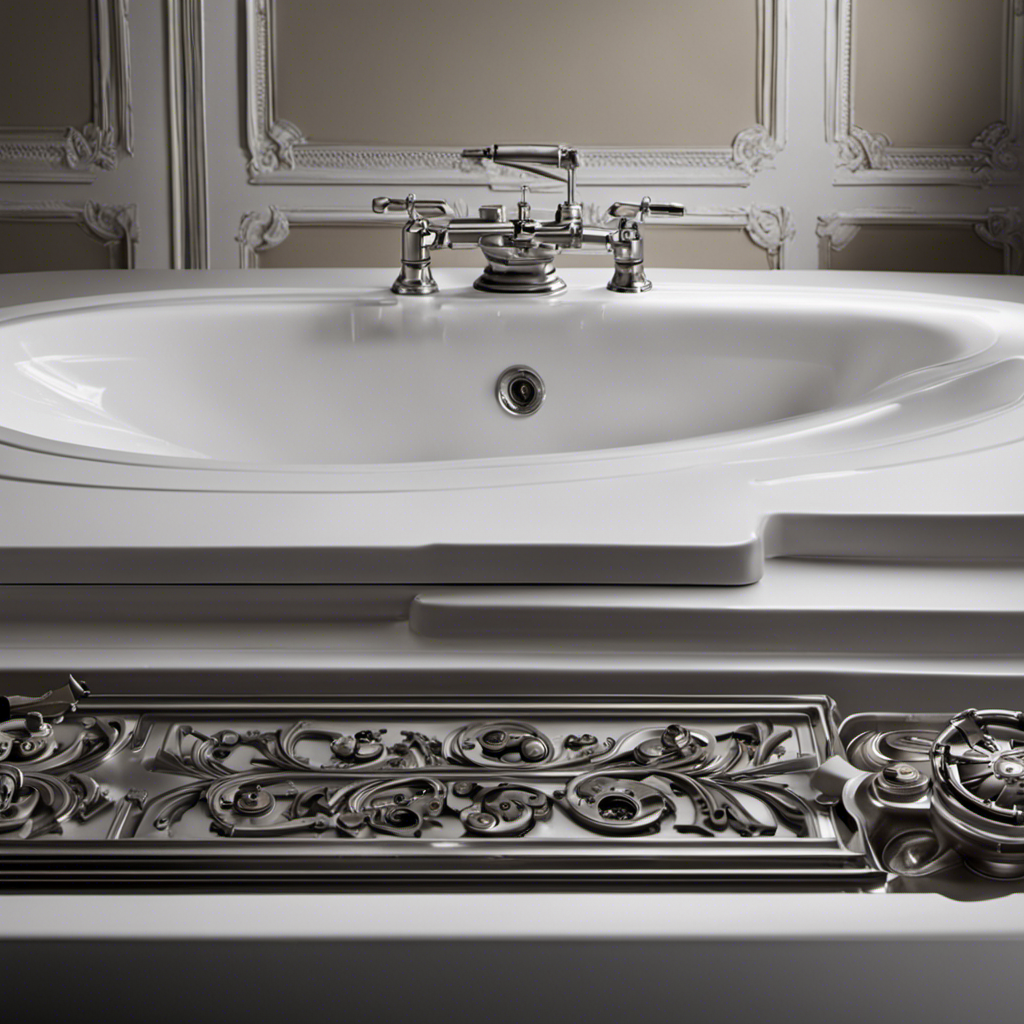Do you ever wonder how many gallons your average bathtub can hold? Well, you’re in luck! In this article, we’ll delve into the depths of bathtub capacities and give you all the information you need.
From standard sizes and calculations to factors affecting capacity, we’ve got you covered.
So, sit back, relax, and let us quench your thirst for knowledge about the gallons in a normal bathtub.
Key Takeaways
- A standard bathtub typically holds around 40-60 gallons of water.
- The material of the tub, such as acrylic, fiberglass, or porcelain-enameled steel, can impact its capacity.
- Factors like the shape, slope, and additional features of the tub can affect its capacity.
- To calculate the volume of a bathtub, measure the length, width, and depth, and then multiply these measurements together.
Standard Bathtub Sizes and Capacities
A standard bathtub typically holds around 40-60 gallons of water.
When it comes to bathtub materials, you have several options to choose from.
The most common materials used for bathtubs are acrylic, fiberglass, and porcelain-enameled steel.
Acrylic is lightweight, durable, and retains heat well, making it a popular choice.
Fiberglass is also lightweight and affordable, but it may not retain heat as effectively as acrylic.
Porcelain-enameled steel is known for its durability and resistance to scratching, but it can be prone to chipping.
As for bathtub design options, you can opt for a built-in tub, a freestanding tub, or a corner tub, depending on your preferences and the available space.
Each design has its own benefits and can enhance the overall aesthetic of your bathroom.
Calculating the Volume of a Bathtub
To calculate the volume of your tub, all you need to do is measure the length, width, and depth. Once you have these dimensions, you can easily determine the volume of your bathtub. Here’s how:
- Measure the length of your bathtub from end to end.
- Measure the width of your bathtub from side to side.
- Measure the depth of your bathtub from the bottom to the top.
After obtaining these measurements, multiply the length, width, and depth together to get the total volume in cubic inches. To convert this volume to gallons, simply divide by 231. If you prefer liters, divide the volume in cubic inches by 61.024.
Understanding how to calculate the volume of your bathtub is crucial in determining its capacity. Factors such as the shape, slope, and additional features can affect the actual amount of water your bathtub can hold.
Factors Affecting Bathtub Capacity
Consider factors such as the shape, slope, and any additional features when determining how much water your tub can hold.
The capacity of a bathtub can be influenced by various factors, including the shape and size of the tub. A rectangular tub, for example, may have a larger capacity than a round tub of the same dimensions. Additionally, the slope of the tub can affect how much water it can hold. A steeper slope may limit the amount of water that can be filled, while a more gradual slope may allow for a greater capacity.
Furthermore, the material of the bathtub can also impact its capacity. Some materials, such as acrylic or fiberglass, may have a larger capacity compared to materials like porcelain or cast iron. It is important to consider these factors when determining the maximum amount of water your tub can hold.
Additionally, it is worth noting that the material of the tub can also affect the water temperature. Materials like cast iron tend to retain heat better, resulting in longer-lasting warm water, while acrylic or fiberglass may not retain heat as efficiently.
Average Gallon Capacity of Common Bathtub Types
When determining the capacity of your tub, you want to know how much water it can hold on average. The average gallon capacity of common bathtub types varies depending on the materials used and the specific design.
Here is a comparison of different bathtub materials and their average gallon capacities:
-
Acrylic: Acrylic bathtubs have an average gallon capacity ranging from 40 to 80 gallons. They are lightweight, durable, and offer a variety of design options.
-
Cast Iron: Cast iron bathtubs have an average gallon capacity ranging from 40 to 60 gallons. They are known for their durability and heat retention properties.
-
Fiberglass: Fiberglass bathtubs have an average gallon capacity ranging from 30 to 60 gallons. They are affordable, lightweight, and easy to install.
-
Porcelain-Enameled Steel: Porcelain-enameled steel bathtubs have an average gallon capacity ranging from 20 to 60 gallons. They are affordable, durable, and easy to clean.
-
Solid Surface: Solid surface bathtubs have an average gallon capacity ranging from 40 to 80 gallons. They are non-porous, low maintenance, and offer a sleek and modern look.
If you are looking for water-saving bathtub options, consider choosing a bathtub with a lower gallon capacity or implementing water-saving features such as adjustable jets or aerators. By selecting the right bathtub materials and considering water-saving options, you can enjoy a relaxing bath while minimizing water consumption.
Tips for Measuring Bathtub Gallons
To accurately measure the capacity of your tub, start by filling it with water until it reaches the desired level.
To measure the dimensions of your bathtub, use a measuring tape to determine the length, width, and depth. Multiply these measurements together to find the volume in cubic inches.
Then, convert the cubic inches to gallons using the conversion factor of 231 cubic inches per gallon. If you prefer to use liters, you can convert gallons to liters by multiplying the gallon measurement by 3.78541.
This will give you the accurate capacity of your bathtub in liters. Remember to consider the shape of your tub as it can affect the overall capacity.
Frequently Asked Questions
Are There Any Regulations on the Minimum or Maximum Capacity for a Standard Bathtub?
There are regulations on the minimum and maximum capacity for a standard bathtub. These regulations ensure that the bathtub can hold a certain amount of water for comfort and safety purposes.
What Is the Typical Water Depth in a Standard Bathtub?
The typical water depth in a standard bathtub is around 12-14 inches. This depth may vary depending on the bathtub’s design and the average bathtub capacity, which is usually between 40-60 gallons.
Can I Install a Larger Bathtub in My Bathroom if I Have the Space for It?
Looking to upgrade your bathtub? Consider the pros and cons of installing a larger bathtub. Will it fit your bathroom space? Will you enjoy the extra room? Evaluate your options carefully.
What Are the Different Materials Used in Manufacturing Bathtubs and How Do They Affect the Capacity?
Bathtub materials, such as acrylic, fiberglass, and cast iron, affect capacity due to their different sizes and cost factors. Determining the number of gallons in a normal bathtub depends on these variables.
Are There Any Additional Features or Accessories That Can Affect the Bathtub’s Capacity?
Additional features and bathtub accessories can affect the capacity of a bathtub. These can include things like jets, whirlpool systems, and overflow drains. It’s important to consider these factors when determining the water volume a bathtub can hold.
Conclusion
So there you have it, folks! After all that technical talk and calculating, it turns out that a normal bathtub can hold a whopping amount of… wait for it… water!
Who would have thought, right? But in all seriousness, it’s important to know the gallon capacity of your bathtub for various reasons, like water conservation and safety.
So grab your measuring tape and find out how many gallons your bathtub can hold. You might be surprised at the answer!










